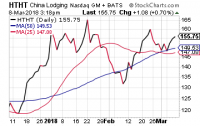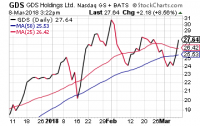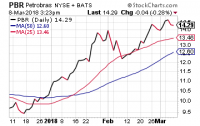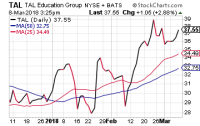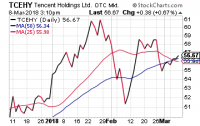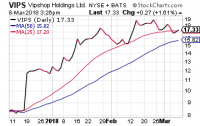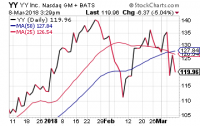With a bumpy market to work with and a few stocks still to report earnings, we take a look at the political risks to the portfolio. We also shift our focus to Brazil, where we find an unusual commodity company and a fresh airline stock to consider.
Cabot Emerging Markets Investor 654
[premium_html_toc post_id="146293"]
Cabot Emerging Markets Timer
The Emerging Markets Timer is our disciplined method for staying on the right side of the emerging markets. The Timer is bullish when the index is above the lower of its two moving averages and that moving average is trending up.
Our Emerging Markets Timer is effectively neutral after its recent positive signal fizzled out last week. Along with most stocks and sectors, the iShares EM Fund (EEM) has been very volatile during the past few weeks, with a sharp rebound off its early-February lows, a big pothole last week and a bounce since then. All told, EEM is hovering right around its 25- and 50-day moving averages, meaning the trend is mostly neutral.
At this point, we’re mostly taking our cues from individual stocks, keeping weak actors on tight leashes but also practicing patience with our resilient performers, all while holding a bit of cash on the sideline.
Not Normal
Not much about investing in emerging markets is normal right now. The major U.S. indexes (The Dow, the Nasdaq and the S&P) are mostly within the trading ranges bounded by the highs and lows of the big January–February correction and the smaller February 27–March 1 retest.
There’s nothing abnormal about either a market correction or a second pullback, and there’s nothing that says that the selling is all over, either. From November 2016 to the end of January 2018, we’ve had two years of advances with only the shallowest of selloffs to remind us of what a down market can do.
What is abnormal is that political risk is as high as I’ve ever seen it. Whether it’s the leader of the U.S. threatening to impose a round of tariffs on steel and aluminum (which, no matter how long it has been under consideration, was certainly a surprise to Wall Street) or the leader of China seeking (and getting) authorization to become a permanent fixture with no time limits, it’s hard for investors to know what will happen next.
And, as we all know, there is nothing investors like less than uncertainty.
In one sense, China’s hint that Xi Jinping might aspire to the job security that Mao once had (and the emperors before him) doesn’t really make much difference to investors. Xi’s agenda doesn’t seem to include much in the way of personal aggrandizement, and his anti-corruption campaign has succeeded to a degree that none of his predecessors ever achieved.
Xi has mostly used his powers to stifle free expression (from our point of view) or maintain order (from his). But he has big plans for expanding China’s economic reach, including the Belt and Road Initiative that will create land and sea lanes that will speed transportation and trade across the entire Eurasian land mass. As proposed, it’s the largest infrastructure project in history, and will, if successful, put China into a commanding position as a 21st century economic leader.
As part of his plan, Xi is making major investments in China’s military, upgrading its ability to project power and (perhaps more importantly) constrain the ability of the U.S. to project power into the western Pacific.
China just reiterated its estimates that its economy will grow by 6.5% in the coming year, a rate that’s regarded as sustainable by most economic observers. There are still big problems to overcome—huge piles of debt, moribund state-owned industries, pollution and civil unrest—but Xi hasn’t put his foot wrong in a big way.
The situation in the U.S. is a little different. At least part of the recent stock market turmoil is directly connected to investors’ fears of what a trade war might mean for U.S. companies. Reports that Canada and our European trading partners are drafting lists of retaliatory duties for U.S. bourbon, motorcycles and other vulnerable targets have hit a nerve. (It’s probably no accident that bourbon is a billion-dollar-a-year export from Kentucky, the home state of Senate Majority Leader Mitch McConnell.)
As the title of today’s commentary suggests, these market influences are not normal. Investors are quite used to following economic data, consumer and investor confidence levels, quarterly and annual reports and M&A activity.
But major disruptions to the national governments of major countries are real black swans. And as much as we pride ourselves on sticking to our stories, numbers and charts, uncertainty about national administrations is an unwelcome distraction.
Featured Stock
Pulp Fact: Fibria Celulose (FBR)
There’s nothing wrong with China stocks, obviously, as we have a portfolio full of them. But Brazil is also thriving, and has a couple of stocks that look particularly good right now.
The first Brazilian stock is Fibria Celulose (FBR), a producer of a commodity that doesn’t get much press, but represents a stable business with excellent demand. The commodity is wood pulp, specifically bleached eucalyptus kraft pulp (BEKP), which is used to make toilet paper, printing and writing paper and some specialty papers. Fibria Celulose is a giant forestry business (market cap is $10.7 billion) that grows and harvests eucalyptus trees (because they reach maturity in seven or eight years and make high-quality kraft pulp) and sells the pulp to Europe, Asia and North America. (Kraft pulp refers to the chemical process that’s used to process the trees into pulp.) Eucalyptus pulp is the biggest segment of the global pulp business by tonnage.
Fibria was formed by a 2009 merger between Aracruz Celulose and Votorantim Celulose e Papel. It has four pulp factories and major forestry operations in the Brazilian states of Bahia and Minas Gerais. The company’s land holdings exceed one million hectares (a hectare is about 2.5 acres). Annual production capacity jumped from 5.3 million tons per year to 7.25 million tons a year when its Três Lagoas mill expansion came online in Q3. And taking exclusive contracts with another Brazilian pulp firm into account, Fibria’s commercialization capacity will be 8.15 million tons per year.
After four years of virtually flat (or slightly negative) earnings, Fibria booked a 24% increase in revenue in 2017, with revenue growth accelerating from a 3% decline in Q1 to a 12% increase in Q2, up 27% in Q4 and up 57% in Q4. Earnings were negative in Q4 2016 and Q2 2017, but increased by 2000% in Q3 and 400% in Q4. The good results in the second half of the year were partly the result of production interruptions in the global industry, which hiked selling prices.
FBR came out of a major correction in August 2016 trading under 6, and recovered to 10 in January 2017. The stock’s advance has been interrupted by frequent and sizable pullbacks, but it’s trading at its highest level since April 2010. Institutional sponsorship took a big jump higher in Q4 and the stock’s 31 trailing P/E isn’t bad, given the positive outlook. Analysts see earnings rising 126% in 2018.
The final factor increasing the attractiveness is that a smaller competitor, Suzano Papel e Celulose, has approached Fibria “to discuss the possibility of a merger to create a global giant.” News that the previously announced talks had been renewed caused FBR to jump from 16.7 on February 15 to 19.6 on February 20, and the stock has held those gains. BUY A HALF.
Fibria (FBR)
Fidencio Ramos, 302
Torre B 3rd floor Vila Olímpia
Sao Paulo, SP 04551-010
Brazil
55 11 2138 4000
http://www.fibria.com.br
The second Brazilian stock is Azul (AZUL), an airline company founded in 2008 that just came public in April 2017. It’s been the fastest growing airline in Brazil since its founding, and is now the third-largest in Brazil with a 32% market share. Azul’s routes connect more than 100 cities in Brazil.
The company turned profitable this year, booking a string of five quarters with double-digit revenue growth and a string of earnings gains that culminated with a 5,600% jump in Q3. The stock is very young (IPO in April 2017), so institutional support (currently 101 whales on board) is still very low. Analysts are looking for 58% earnings growth in 2018.
Azul reported its Q4 results yesterday (March 8). The company reported record fourth quarter operating results, which was achieved even with a 16% increase in fuel prices year over year. Net income totaled R$303.7 million, representing an improvement of R$252.4 million over 4Q16. Net income in 2017 came in at R$529.0 million, compared to a net loss of R$126.3 million the year before. Passenger traffic grew 12.7% on a capacity increase of 10.2%, resulting in a load factor of 82.7%, 1.9 percentage points higher than in 4Q16. WATCH.
Azul (AZUL)
Av. Marcos Penteado de Ulhôa Rodrigues, 939
Edif. C. Branco Office Park
Torre Jatobá 9º andar Alphaville Industrial
Barueri, SP 06460-040
Brazil
http://www.voeazul.com.br
Model Portfolio
Invested 80% Cash 20%
Updates
Along with just about every other group, emerging market stocks are in their sixth week of correction and consolidation and remain mostly neutral at this point—the iShares EM Fund (EEM) is stuck right around its 25- and 50-day moving averages, which, for now, means the intermediate-term trend is effectively neutral.
We won’t predict what the next big move will be—we still think the overall bull market is intact, but whether this correction has another leg down is anyone’s guess. Right now, we’re mostly focused on our stocks and giving them rope (if they’re holding up well) or tightening stops (if we see abnormal action).
Alibaba (BABA) remains active on the business front—the company is expanding a deal it has with Renault that will allow Chinese consumers to buy Renault cars through Alibaba’s Tmall platform. But despite its various moves, BABA is still in a holding pattern that dates back to last October. The gap up on Tuesday is interesting, but we need to see more evidence that the major uptrend is resuming before advising new buying in the name. HOLD.
Autohome (ATHM) released a mixed quarterly report yesterday—earnings of $1 per share easily crushed expectations, and sales also topped expectations (media service revenue rose 32% and lead-generation sales were up 29%), but it’s Q1 guidance was just OK even after factoring in some accounting changes. The stock initially fell sharply on the news, but has exploded to new highs since. It’s very bullish action—we’ll go back to Buy. BUY.
BeiGene (BGNE) continues to act very resiliently; its three-day pullback last week was met with strong buying pressures (four straight days of above-average volume buying). BGNE is speculative, but many biotech stocks are holding firm, and the company’s enticing partnerships lend it credibility. We’re OK with a buying a half-sized position here or (preferably) on dips of a few points. BUY A HALF.
China Lodging Group (HTHT) will release earnings on March 13, which, along with the overall market, will probably determine the stock’s next big move. HTHT’s huge run during the past year and a half certainly raises risk, but it’s set up a nice launching pad since mid-October and, of course, the growth potential is huge as it expands its hotel count. Analysts see earnings up 45% this year, but all eyes will be on management’s outlook next week. HOLD A HALF.
GDS Holdings (GDS) was switched to Hold last week, as the stock sagged a bit more than we’d prefer. Still, overall, GDS’ consolidation since the start of February looks normal given its big prior advance, and fundamentally, analysts see revenues accelerating this year (57% growth vs. 50% for 2017) as the firm’s data center business booms. That said, earnings are due out on March 13 (next Tuesday), which will probably tell the tale. A positive reaction would probably create a solid entry point given the recent consolidation, but we’ll have to see what comes. HOLD.
We think Petrobras (PBR) could be a very powerful turnaround story as it puts the scandals and turmoil of the past few years behind it, and as energy prices remain firm. Management indicated that it’s receiving interest for its Pasadena refinery in Texas, which it’s looking to sell as part of its huge deleveraging program ($21 billion of divestitures between last year and this year). Going along with that was today’s announcement of a new $4.35 billion credit facility (with 17 banks), which can be used to pay off near-term debt maturities. The top brass also said it’s sticking with its target of boosting overall energy output by 30% from 2018 through 2022. The more positive moves the company makes, the more faith big investors have that the turnaround is real. The stock remains resilient, hitting new highs each of the past two weeks. Earnings are likely out within a couple of weeks. You can buy a half-sized position here or on dips. BUY A HALF.
TAL Education (TAL) ripped to new highs after the market’s early-February low (breaking out of a four-month consolidation) before pulling back to its 25-day line in recent days. But TAL has been moving higher since and looks like it wants to get moving if the market does. BUY A HALF.
Tencent Holdings (TCEHY) looks exactly like the iShares EM Fund, with the stock very volatile in recent weeks and currently sitting near its 50-day line. The digital music service Spotify has filed to go public, and with a 7.5% stake, Tencent could cash in—early estimates say that Spotify’s total valuation could be $20 billion, meaning Tencent’s stake could be worth $1.5 billion. The company will release earnings on March 21, which will obviously be key. As a blue chip outfit and a relatively resilient chart, we’re OK taking a small position around here. BUY A HALF.
Vipshop (VIPS) still looks fine overall, pulling back to its 25-day line during the past two weeks. Having bought in mid-February, we do have a small loss, and there has been some big-volume selling (such as this Tuesday). If we see more weakness, we could shift to a Hold rating, but right now, we still think this dip provides a good entry point. Analysts see earnings up 21% this year and 20% next. BUY.
Weibo (WB) has been choppy but resilient, with each dip during the past few weeks bringing in buyers around the 50-day line. The growth story doesn’t get much better than Weibo’s (analysts see earnings up 56% this year and 43% next), and the stock’s action tells us the next big move is likely up. That said, with the market iffy, it’s prudent to try to buy on dips. BUY.
YY Inc. (YY) looked like it was cooked on Wednesday, when a promising earnings report (sales up 55%, earnings up 56%) didn’t do much to stop the sellers from driving YY down 20 points from high to low. YY bounced afterwards, but ran into big-volume selling again yesterday. The giant weekly volume and resistance at 140 tells us that it’s best to take the rest of our profit. SELL.
[premium_html_footer]
Send questions or comments to paul@cabotwealth.com.
Cabot Emerging Markets Investor • 176 North Street, Salem, MA 01970 • www.cabotwealth.com
All Cabot Emerging Markets Investor buy and sell recommendations are made in issues or updates and posted on the Cabot subscribers’ website. Sell recommendations may also be sent to subscribers as special alerts via email. To calculate the performance of the hypothetical portfolio, Cabot “buys” and “sells” at the midpoint of the high and low prices of the stock on the day following the recommendation. Cabot’s policy is to sell any stock that shows a loss of 20% in a bull market (15% in a bear market) from our original buy price, calculated using the current closing (not intra-day) price. Subscribers should apply loss limits based on their own personal purchase prices.
THE NEXT CABOT EMERGING MARKETS INVESTOR ISSUE IS SCHEDULED FOR March 22, 2018
We appreciate your feedback on this issue. Follow the link below to complete our subscriber satisfaction survey: Go to: www.surveymonkey.com/chinasurvey
Cabot Emerging Markets Investor is published by Cabot Wealth Network, an independent publisher of investment advice since 1970. Neither Cabot Wealth Network, nor our employees, are compensated in any way by the companies whose stocks we recommend. Sources of information are believed to be reliable, but they are in no way guaranteed to be complete or without error. Recommendations, opinions or suggestions are given with the understanding that subscribers acting on information assume all risks involved. © Cabot Wealth Network 2017. Copying and/or electronic transmission of this report is a violation of the copyright law. For the protection of our subscribers, if copyright laws are violated, the subscription will be terminated. To subscribe or for information on our privacy policy, visit www.cabotwealth.com, write to support@cabotwealth.com or call 978-745-5532.
[/premium_html_footer]









